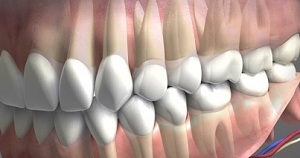 Translated from Latin in the dental sense, occlusion means contact between the dentition of the upper and lower jaws at rest. In the popular conversation the term "bite" is used.
Translated from Latin in the dental sense, occlusion means contact between the dentition of the upper and lower jaws at rest. In the popular conversation the term "bite" is used.
At the age of 4 to 6 years, the most active formation of the dentoalveolar system takes place. Therefore, most violations of occlusion occur during this period. Because of this, it is important to monitor the child's habits and not let him suck fingers and nipple for a long time.
Because this forms a person's wrong swallowing and pushes the lower jaw forward. Often anomalies in development occur due to diseases of the upper respiratory tract, especially the nasopharynx.
Finally, the dental jaw system completes its formation by the age of 16, therefore, until this age, most of the defects are much easier to correct. Therefore, it is important to check with the dentist every year to determine the wrong occlusion in a timely manner and begin correction at an early stage of development.
Contents
- Contemporary classification
- Current classification
- Distal occlusion
- The mesial form of the anomaly
- Classification by location
- Open and deep bite
- Causes of anomalies
- Treatment and correction are general approaches
- Current classification
Current classification
Specialists share occlusion in a permanent and temporary. The latter variant occurs during the active formation of the 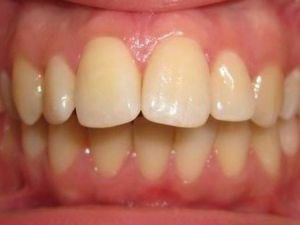 dentition system in the period from 4 to 6 years, when the child has more than 20 milk teeth.
dentition system in the period from 4 to 6 years, when the child has more than 20 milk teeth.
During this period, the joints and muscles of the jaws gradually adjust to the most advantageous positions. Incorrect bite can be classified according to developmental anomalies and small deviations in location.
The incorrect formation of the occlusion by the arrangement of the upper row of teeth relative to the lower one is divided into two types - distal and mesial.
Distal occlusion of
A distal occlusion is the notable shift of the upper dentition forward. Similar changes occur because of the underdevelopment of the lower jaw( low activity when breast sucking in childhood).The characteristic external features for this pathology are:
- the difficulty of closing the lips;
- upper jaw seems larger than the lower one;
- visual enhancement of the nose;
- on the chin has a characteristic fold.
In addition, there is a classification of distal occlusion due to improper formation:
- Skeletal .The problem arises from the incorrect development of the jaw bones.
- Zuboalveolar .Anomaly occurs because of incorrect operation of muscles and joints when jaws are closed.
The mesial form of the anomaly
With mesial occlusion, the lower jaw protrudes forward. Sometimes called anterior occlusion. In the areas of contact of the dentition, a characteristic step appears. Changes occur because of incorrect development of pterygoid muscles.
There are 3 degrees of development of pathology:
- The initial stage of is characterized by a gap between the dentition in the range of 0-2 mm. Between the molars( molars), the sagittal distance( in the anteroposterior direction) is less than 5 mm. The non-submandibular angle is less than 131 degrees.
- On the of the second stage of the , the gap is within 6-10 mm. Between the molars the displacement is up to 10 mm. The angle is from 132 to 133 degrees.
- The last degree of differs marked changes. The slot has a size of more than 10 mm. The distance between the molars is from 11 to 18 mm. Angle up to 145 degrees.
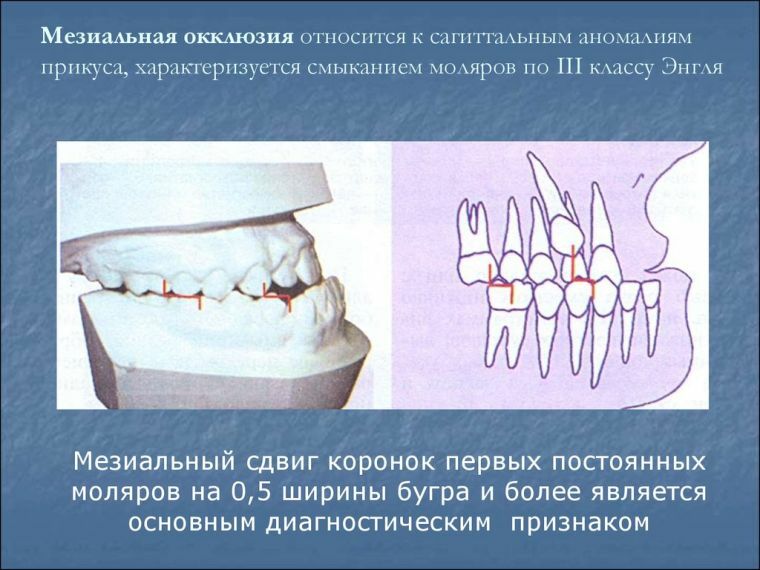
At the initial stage of development, the jaw can be independently displaced back to the required position. Further treatment requires more serious methods.
External features are:
- noticeable extension of the chin with the lower lip forward;
- upper lip overlaps the lower;
- visible gap in the closed state;
- the middle profile part of the face changes outwardly and looks concave;
- appearance of the face resembles an angry state.
As a rule, with mesial type of bite, a person has problems with correct pronunciation of sounds( dyslalia).With a strong bias, it is difficult to bite and chew food, jaw muscles are regularly overloaded due to improper load distribution.
Classification by location
Variation in the displacement of the upper and lower jaws subdivides the occlusion into the anterior, central and lateral. In contrast to the above described species, these forms of impairment have less influence on the appearance of a person and the functional capabilities of the dentoalveolar system.
Features of each type of violation:
1. Central occlusion of teeth. In this case, all groups of jaw muscles work correctly, so the upper and lower jaws are exactly one above the other. There are no gaps between the upper and lower dentition. Connections between the teeth occur with the maximum number of contacts.
2. Side occlusion. This shape is characterized by the displacement of one of the jaws to the left or to the right of the central position. Because of this, the central line between the incisors is displaced.
3. The anterior bite is characterized by a slight extension of the mandible. Thus the position of the jaws is not disturbed, the person does not experience discomfort.

Front open bite
These kinds of occlusions are natural to humans and are observed in most people. In life, almost no effect on chewing, speech quality or appearance of the face.
Sometimes there is a mixed appearance of occlusion, in which the jaws are simultaneously shifted to the side and up or down. A similar bite is called cross.
Open and deep bite
Separately, mention should be made of open occlusion. This form of abnormal development of the dentoalveolar system is caused by the physiological factor. A person does not close certain groups of teeth.
According to statistics, 2% of patients with tooth-jaw problems are found. Sometimes the problem is combined with mesial or distal occlusion. As well as a deep occlusion refers to vertical anomalies in the development of the dentoalveolar system. The appearance of an open form of disorder is mainly due to a mother's illness during pregnancy.
Deep occlusion looks like a distal occlusion, but differs in that the lower row of teeth overlaps with the upper ones. There are 2 degrees:
- incisors touch each other;
- incisors do not touch.
According to statistics, among the anomalies in the development of the dental system this form is found in 50% of patients. In most cases, it is transmitted genetically from the parents, but it can also appear as complications due to various dental and ENT diseases( rickets, hypotrophy, violation of the cutting time of the baby teeth, etc.)
Causes of anomalies
For all anomalies in bite development,factors are:
- of a mother's illness during pregnancy;
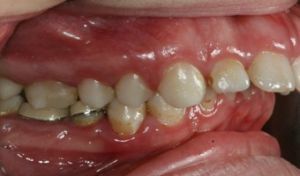
- hereditary predisposition;
- thumb sucking;
- upper respiratory tract diseases:
- chronic otolaryngological diseases;
- wrong chewing food since childhood;
- physical injuries to the jaws.
Treatment and correction - general approaches
If a person has minor deviations from a physiologically correct occlusion, then treatment may not be required. Sometimes, for an easy correction, short-term use of orthodontic structures and( or) braces is sufficient.
To diagnose abnormal occlusion, the patient should consult one of the following specialists:
- dentist;
- dentist-orthodontist;
- maxillofacial surgeon;
- is a dentist-therapist.
After the examination, the specialist will choose the most suitable method of treatment:
- installation of brackets;
- wearing orthodontic devices( kapy, veneers, screws, vestibular plates, etc.);
- surgical correction.
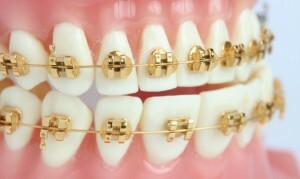 At the reception, the doctor examines the patient and determines the extent of occlusion impairment. Typically, the patient is placed one of the orthodontic structures and then periodically follows the correctness of the treatment.
At the reception, the doctor examines the patient and determines the extent of occlusion impairment. Typically, the patient is placed one of the orthodontic structures and then periodically follows the correctness of the treatment.
The most common and effective method of correction is the installation of breccet systems. Sometimes a surgical operation may be required to correct the dentoalveolar system.
Incorrect occlusion disrupts the functionality of a person, and also causes discomfort due to a violation of the appearance of the face. Therefore, it is important to determine the pathology at the initial stage of development and start its treatment in time.
